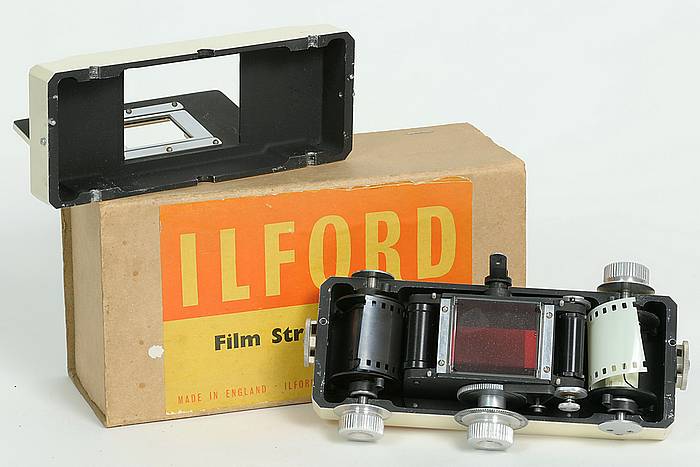| ILFORD (KI) FilmStrip Printer |
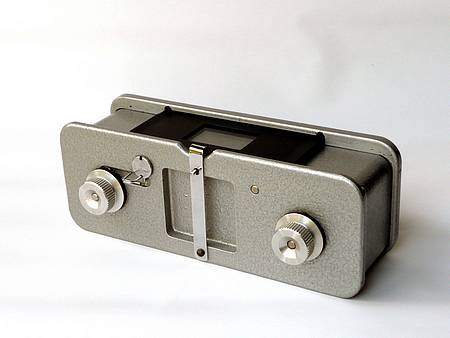 |
|
|
|
|
|
Thanks to Paul Godfrey for sending me the above picture of the later version of the Ilford Filmstrip printer and a copy of the instruction booklet. Paul says "This was definitely made by Kennedy Instruments (KI); it even has Ilford Advocate aluminium knobs on it". "This is a simplified version of an earlier printer introduced in 1951: ref. review on p236 of the BJPA for 1951 (printed early months of 1952)." For the earlier version, scroll down to see Doug McKee's pictures below. This later version (as pictured
above) was introduced in 1956; it appears in Ilford's 1956 catalogue
& was reviewed in the 1957 BJPA, p174 ~ thanks to Doug McKee
for this information. Paul says "The negatives are held in contact with sensitised material by glass; for paper contact strip prints this would have been fine but for making projection quality monochrome slides, dust spots would have been a problem. There are no Ilford badges on this printer but luckily my one came with the original instruction booklet, so a non-enthusiast could identify what it is. I think it is probable that these printers are found and thrown away because the finder does not know what the item is." Doug McKee informs me that the price shown in his 1956 catalogue for this later version is £8.10s (£8.50p) but the catalogue's addendum price list for November 1956 states £8, which is the same as in the 1957 BJPA review (which would have been compiled and published in early 1958). In early 1968 it was priced at £11.15s (£11.75p; ref. Amateur Photographer magazine for 21st February 1968, p63). Modern Camera Magazine reviewed the Film Strip Printer in their April 1957 issue, when it was priced at £8.8s (£8.40p) For the full review, see below. |
|
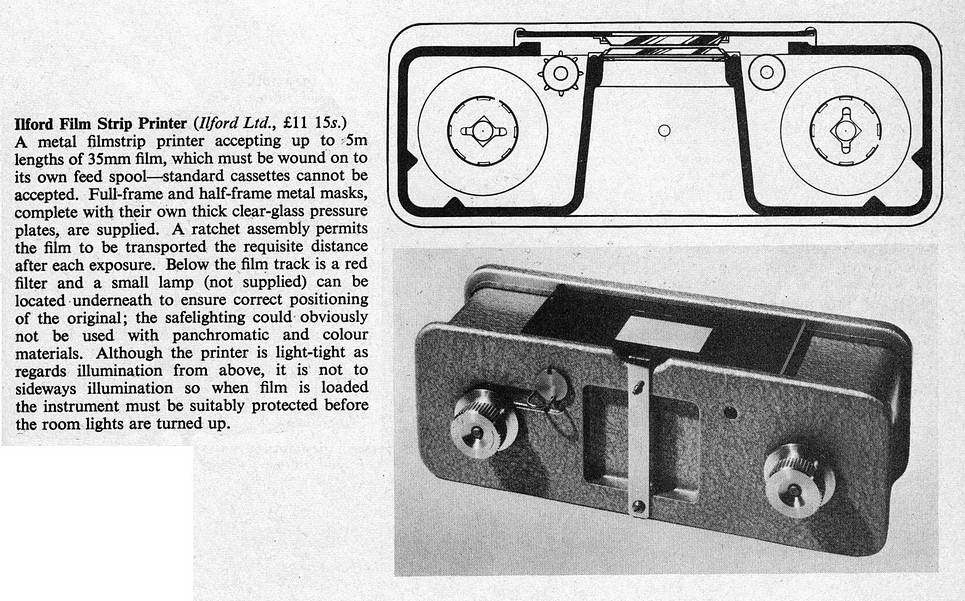 Taken from Amateur Photographer magazine, 21st February 1968 |
|
 To download the instruction booklet (dated spring 1957, which confirms the above dates) as a pdf file, click here or on the image alongside. |
|
| Modern Camera
Review, April 1957 Ilford Film Strip Printer |
|
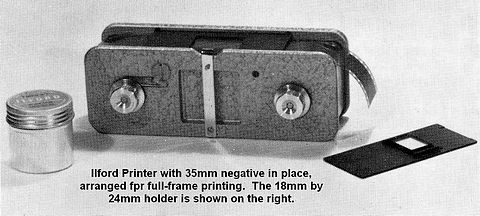 |
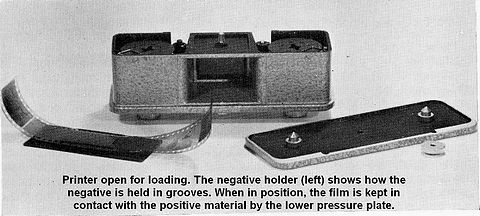 |
|
The device consists essentially of a light-proof body containing two film spools, one for the feed and the other for the take-up, designed to accommodate up to 5metres of special Ilford Fine-Grain Safety Positive film or Ilford perforated bromide paper. The film is wound on to the spool emulsion side inwards in the ordinary way, and is brought up from this spool and over the main roller in such a way as to bring the sensitive surface upwards. The film then goes over a sprocket wheel on to the take-up spool. In passing between the two spools it runs over a polished glass plate which is spring-loaded. Behind this glass plate is a red safelight filter above a large aperture which opens right to the back of the casing. A negative film carrier, also with a polished glass plate, takes the 35 mm. negative which can be fed into a pair of grooves. When the negative holder has been slipped in position on the top of the instrument, with the emulsion side of the negative against the emulsion of the positive film, the spring behind the lower pressure plate keeps the two surfaces in firm contact. If now the casing is placed over a small light-box (such as a small safelight lamp with a piece of ground glass or flashed opal in place of the safelight itself) the red safelight filter in the casing will prevent any fogging of the positive film, but will let enough light through this film and the negative to enable the latter to be accurately placed in the aperture. To expose the film or paper, the box with negative in position is stood under either a low-power lamp in a vertical holder such as an Anglepoise lamp or the equivalent, and the exposure made, or alternatively it can be stood on the baseboard of a vertical enlarger and the enlarging light used. In order to find the correct exposure a few tests must be made, but once these tests have been made for the average negative likely to be used, the experienced user's judgment will enable him to obtain consistent exposure for his various negatives. When the exposure has been made, the wind knob is turned until it is stopped by a spring engaging a notch. One turn is sufficient for the 18mm by 24mm size of film strip frame, but for the full 24mm by 36mm frame the lever must be pressed a second time and wound on. We mentioned earlier in this review that if the user has a 35mm. enlarger with sufficient extension to project at the same size, then printing can be done by projection from the enlarger and in this way portions of the frame can be selected to suit the subject. The printer is well made, in
hammered grey finish, and is accompanied by a comprehensive instruction
book. We had no difficulty at the first trial in producing a
good film strip as well as individual monochrome frames for showing
in 2in. by 2in. projectors and we found the projection printing
a great convenience in choosing the best part of a number of
frames of landscape films. The price is £8.8s.0d. Submitted
by Ilford Limited. |
|
| ILFORD 35 mm. FILM STRIP PRINTER ~ earlier version | |
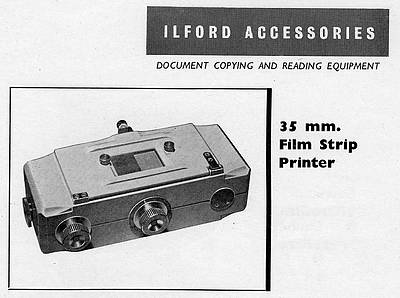 The case is of cast metal, finished in stoved ivory enamel. The dimensions are 7x3½x2in (18x9x5cm), and the weight 1¾ lbs (0.8kg) A leather storage case is available. Price: £2 17s. 6d. (£2.88p) |
Reviewed in the 1951 BJPA (hence its likely the item first appeared in 1950) and also featuring in Ilford's 1952 (and 1955) General Catalogue, Section 8-B: "Accessories for Professional Photography", is the earlier Filmstrip Printer, as shown alongside and also in the photographs below. The description reads: ILFORD 35 mm. FILM STRIP
PRINTER; Price: £12
10s. 0d in 1952 (£12.50p ~ though £12 in 1950 when
first marketed). |
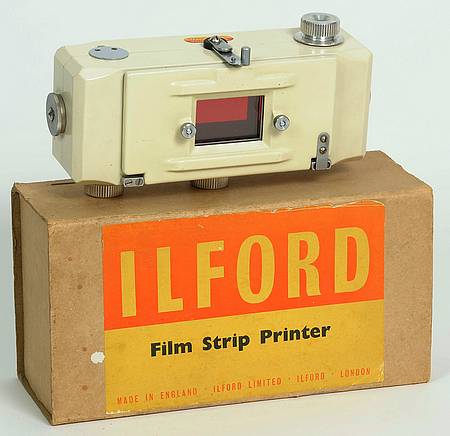 |
Doug McKee has sent me photographs (left and below) of this earlier 'Advocate look alike' film strip printer, as advertised above. This earlier version has an extra knob for zeroing the frame counter. This seems to be the only practical difference between this earlier version and the later, stove enamel version, shown at the top of this page. In the picture to the left, the label hiding behind the central lever reads "Ilford". The central, forward pointing, lever has two functions: (a) it holds the front strip retaining plate closed by engaging on a small detent pin to the left of the vertical peg, and (b) is used to release the wind on mechanism. Doug believes the method of operation is as follows: Once a frame has been exposed the strip retaining plate has to be opened by releasing the sprung central lever from its detent pin (by easing the lever upwards) and pulling the vertical peg outwards, which clears the way for the central lever to be pushed towards the right. This internally releases the sprockets and the wind on can commence using the top knob. Once the film has started to travel the central lever can be released. |
|
The peg on the hinged front plate (lying horizontally in the left hand side of the picture) prevents inadvertent wind on release. The peg is securely attached to the strip retaining plate and is in fact something to hold, when opening the retaining plate. |
|
|
In the picture left, the knob at bottom centre has a toothed wheel which has a sprung arm engaged with it like a ratchet, visible in the picture. The knob can be rotated to zero the dial. In use, a cam on the sprocket shaft pushes against the spring to increment the dial. |
|
 |
An even earlier version of the Ilford Filmstrip Printer. Doug McKee reports that he has now (November 2010) acquired a little Ilford textbook entitled "35mm Filmstrip Technique" by Peter Hansell (a man of the same name had an involvement with the Ilford Monobar design but it is uncertain whether these two men are one and the same). This textbook was printed in 1949 but the author's foreword is dated December 1948. This textbook includes the image (alongside) of an even earlier filmstrip printer.
|
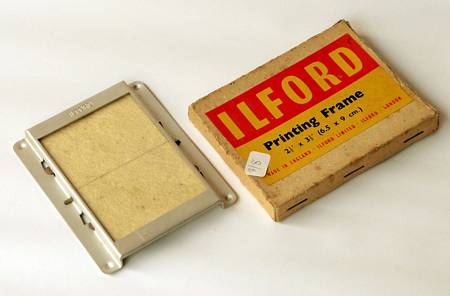 |
Paul Godfrey bought this Ilford metal contact-printing frame from an Ebay trader. He says: "Andy Holliman mentions in his book that Kennedy Instruments made various accessories (including a printing frame) for Ilford, before embarking on the Advocate project just after the end of WW2. I therefore think it is possible that Kennedy made this item, but of course I cannot be sure." The original (?) price, as can be seen on the label attached to the box lid, was 3s/8d (18p). |
|
|
|
|
|
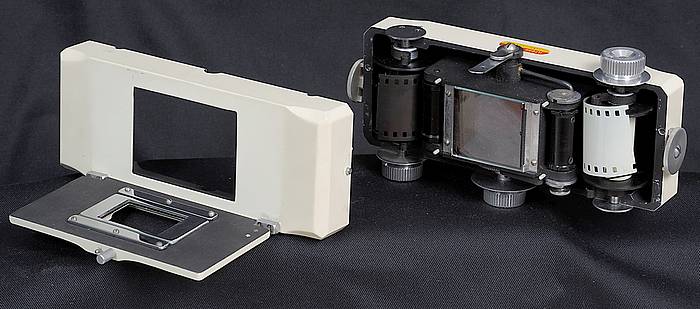 In the right hand side of the picture
can be seen a curved-end rod coming from the shaft under the
central lever. This rod engages with cut-outs in the round end
plate of the sprocket wheel. Quite a small movement to the right,
by the central lever, is all that is required to release the
rod from the cut-out, allowing the wind-on sprockets to rotate.
In the right hand side of the picture
can be seen a curved-end rod coming from the shaft under the
central lever. This rod engages with cut-outs in the round end
plate of the sprocket wheel. Quite a small movement to the right,
by the central lever, is all that is required to release the
rod from the cut-out, allowing the wind-on sprockets to rotate.